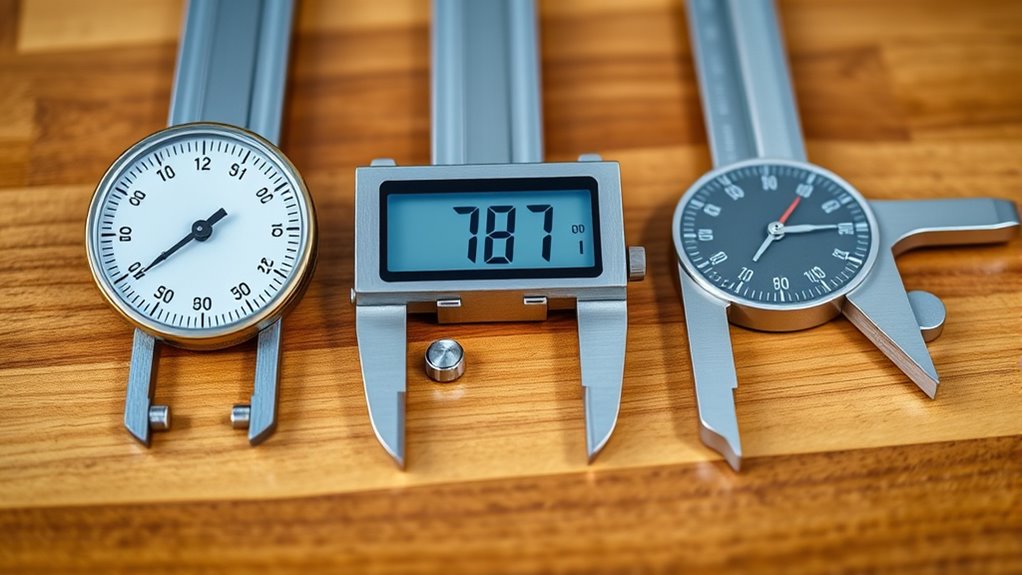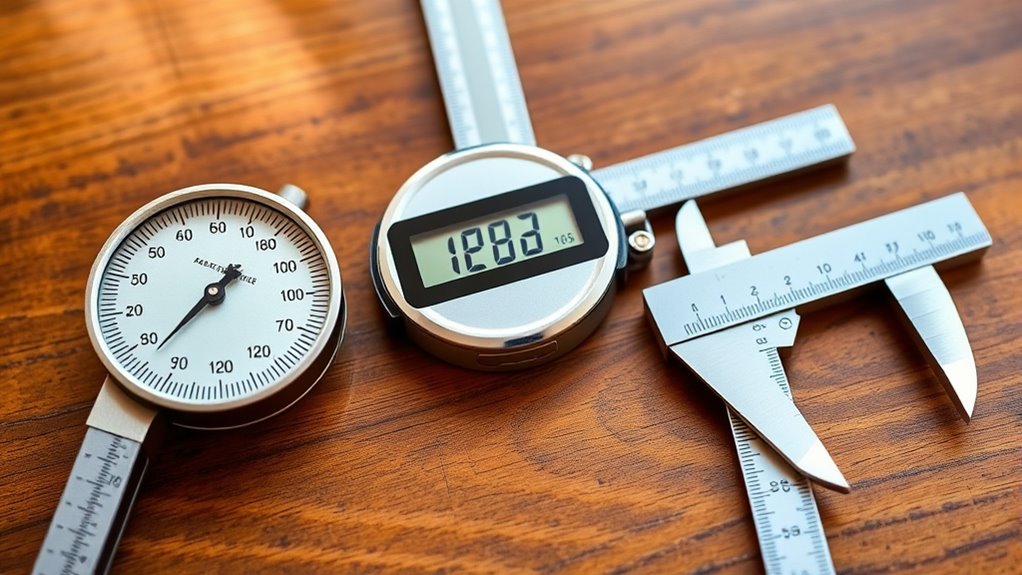When choosing between dial, digital, and vernier calipers, consider your needs for accuracy, ease of use, and durability. Dial calipers are reliable and simple to read, ideal for traditional use without batteries. Digital calipers offer quick, easy readings and unit toggling, perfect for efficiency. Vernier calipers provide high precision but require more skill. To find the best fit for your projects and learn more about their features, keep exploring further.
Key Takeaways
- Consider your skill level; dial and vernier calipers require more reading accuracy, while digital calipers offer easier, quicker measurements.
- Evaluate your working environment; mechanical calipers (dial and vernier) are more resistant to dust and moisture than digital models.
- Determine measurement precision needs; vernier calipers excel in detailed, high-accuracy tasks compared to dial and digital types.
- Account for maintenance preferences; digital calipers need battery care, whereas dial and vernier are generally low-maintenance.
- Choose based on budget and durability; stainless steel versions across all types ensure long-lasting performance in demanding applications.

Choosing the right calipers is vital for obtaining accurate measurements, whether you’re working on a DIY project, machining, or woodworking. Your choice directly impacts measurement accuracy, which is essential for ensuring your project’s success. Additionally, you’ll want calipers made from durable materials to withstand regular use and resist wear over time. The type of caliper you select—dial, digital, or vernier—affects how easily you can achieve precise readings and handle various working conditions.
Selecting the right calipers ensures accurate measurements and long-lasting durability for your projects.
Dial calipers are known for their reliability and ease of use. They feature a mechanical dial that provides a clear, analog display of measurements. Because they don’t require batteries, dial calipers are often preferred in environments where power sources are limited or where you want a simple, dependable tool. Their measurement accuracy is generally high, especially when properly calibrated, making them suitable for tasks that demand precision. The material durability is also a key factor; many dial calipers are made from stainless steel, which resists corrosion and withstands rough handling, ensuring longevity even with frequent use.
Digital calipers, on the other hand, offer the advantage of quick, easy readings at the push of a button. They display measurements on an electronic screen, which reduces the risk of human error and speeds up your workflow. These calipers are particularly useful when you need to switch between metric and imperial units often, as they can toggle between units instantly. The measurement accuracy of digital calipers is comparable to dial calipers, often within thousandths of an inch or hundredths of a millimeter. Their material durability is also notable—most are constructed from stainless steel or other corrosion-resistant alloys, making them suitable for both indoor and outdoor use. However, they do require batteries, and you should handle them carefully to avoid damage from moisture or impacts that could impair their electronic components. Proper calibration and maintenance can extend their lifespan and ensure consistent precision.
Vernier calipers are the traditional choice, offering a high level of precision through a finely graduated scale. They’re usually made from stainless steel or other durable metals, making them highly resistant to wear and capable of providing consistent measurement accuracy over time. While they require a bit more skill to read accurately, they’re valued for their reliability and long-lasting durability. Vernier calipers are great for detailed work where measurement accuracy is paramount, and their sturdy construction ensures they can handle the rigors of demanding environments.
Frequently Asked Questions
Which Type of Caliper Offers the Best Durability?
You’ll find that dial calipers generally offer the best durability because they often feature robust materials like stainless steel and have good environmental resistance. These calipers withstand moisture, dust, and rough handling better than some digital or vernier types. If you need a tool that lasts in tough conditions and resists corrosion, a dial caliper made from high-quality material is your best choice, ensuring longevity and reliable measurements over time.
How Do I Calibrate My Digital Caliper?
To calibrate your digital caliper, start by turning it on and closing the jaws completely. Press the zero button to set it to zero, ensuring measurement accuracy. Then, open the jaws and measure a standard object, like a calibration block or gauge. Adjust if necessary, following the manufacturer’s instructions. Regular digital calibration helps maintain precise measurements, so check it periodically, especially after drops or impacts.
Are Vernier Calipers Suitable for Measuring Internal Dimensions?
Vernier calipers are suitable for measuring internal dimensions, but they require careful technique for good internal measurement accuracy. You should use the smaller jaws inside the caliper to measure internal gaps or holes, ensuring they are snug without forcing. When comparing caliper materials, stainless steel offers durability and resistance to corrosion, maintaining measurement accuracy over time. Proper calibration and handling also help make certain of precise internal measurements.
What Maintenance Is Required for Dial Calipers?
Did you know that neglecting proper maintenance can reduce a dial caliper’s accuracy by up to 20%? To keep yours in top shape, regularly clean the caliper and apply caliper lubrication to prevent rust. You should also check calibration frequency, ideally once a month, to ensure precise readings. Store it in a protective case when not in use, and avoid over-tightening the spindle to extend its lifespan.
Can All Calipers Measure Both Metric and Imperial Units?
Yes, all calipers can measure in both metric and imperial units. You just need to switch the unit setting or read the measurement accordingly, which helps with unit conversion. This versatility enhances measurement accuracy because you can easily compare different measurement systems without needing separate tools. Whether you’re using dial, digital, or vernier calipers, guarantee you understand how to toggle units for precise, reliable readings.
Conclusion
Now that you know the differences, imagine holding your chosen caliper—feeling its weight, hearing the satisfying click, trusting its precision. Whether the classic dial, sleek digital, or versatile vernier, each becomes an extension of your hand, guiding you with confidence. As you measure with clarity and ease, you’ll unseal new levels of craftsmanship. Embrace your choice, and let it inspire accuracy and pride in every project you touch.









